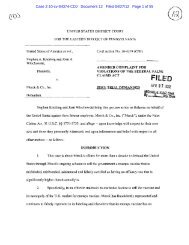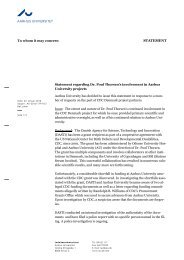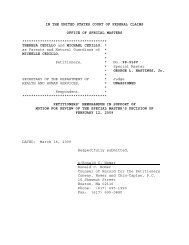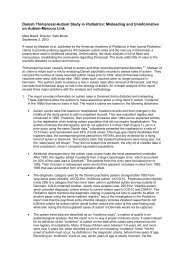Brief SWOT Analysis and Vaccine Safety Communication/Media ...
Brief SWOT Analysis and Vaccine Safety Communication/Media ...
Brief SWOT Analysis and Vaccine Safety Communication/Media ...
Create successful ePaper yourself
Turn your PDF publications into a flip-book with our unique Google optimized e-Paper software.
DRAFT <br />
<strong>Brief</strong> <strong>SWOT</strong> <strong>Analysis</strong> & <br />
<strong>Vaccine</strong> <strong>Safety</strong> <strong>Communication</strong>/<strong>Media</strong> Strategy<br />
Situation:<br />
In the United States, vaccination against childhood diseases are at all time highs,<br />
while most cases of vaccine preventable diseases are at or near all-time lows.<br />
Immunization against disease is widely recognized as one of the most effective techniques<br />
of preventive medicine. However, last year in the United States, the number of reported<br />
adverse events associated with vaccination was greater than the number of reported<br />
cases of vaccine-preventable disease.<br />
With the disappearance of a perceived threat in the United States from these diseases, the safety<br />
of routine childhood vaccination is increasingly under fire. Assaults against routine vaccination<br />
are occurring in the United States <strong>and</strong> in many developed nations worldwide (e.g., United<br />
Kingdom, Germany, Austria, Switzerl<strong>and</strong>, Netherl<strong>and</strong>s, France, <strong>and</strong> states of the former Soviet<br />
Union). In the United States, the arguments against vaccination appear to be increasing in<br />
numbers <strong>and</strong> velocity (e.g., Money, La Times, New Yorker, Today Show, Clevel<strong>and</strong> Plain Dealer).<br />
In addition, the voice against vaccination is becoming more organized <strong>and</strong> seems to be moving<br />
toward the reversal of state school-entry immunization laws, which act as the public-health safety<br />
net to ensure high levels of vaccination among children in the United States.<br />
In the United States, as elsewhere, the critics of vaccination fall into a few predictable categories:<br />
• Religious objectors<br />
• Hostile parents <strong>and</strong> non-professionals who envision vaccines as more harmful to<br />
individual children than good or believe in conspiracy theories related to vaccination<br />
programs<br />
• Proponents of alternative medicine <strong>and</strong> naturalists<br />
• Health care professionals <strong>and</strong> scientists who doubt the benefits of immunization <strong>and</strong> fear<br />
long-term effects of vaccination.<br />
Concerns range from the belief that vaccines are not effective to concerns that vaccines do<br />
measurable harm today <strong>and</strong> long-term. Although these arguments may develop from divergent<br />
perspectives, these groups tend to share <strong>and</strong> reinforce each other’s motivations. And, with the<br />
increase use of media advocacy by small organized special interest groups to promote societal<br />
change, the possibility of critics against vaccination gaining strength <strong>and</strong> voice in public health<br />
policy decisions at local, state <strong>and</strong> national levels warrants serious consideration. For example, in<br />
Japan <strong>and</strong> Sweden, the anti-vaccine movement’s message diffused from small organized groups<br />
to mainstream popular acceptance, which led to changes in vaccination policy <strong>and</strong> severe drops<br />
in vaccination levels <strong>and</strong> increased morbidity <strong>and</strong> mortality from vaccine-preventable diseases.<br />
Some of the concerns put forth by critics of routine vaccination include:<br />
• Complications of immunization (e.g., VAPP, seizures, encephalopathy, possible chronic<br />
sequela)<br />
• Multiple <strong>and</strong> concurrent vaccinations may suppress a child’s developing immune system<br />
• Immunizations trigger other chronic immune <strong>and</strong> metabolic diseases (e.g., diabetes,<br />
cancer, asthma, rheumatism <strong>and</strong> multiple sclerosis)<br />
• Immunizations may cause behavior problems (e.g., ADD, autism <strong>and</strong> hyperkinesis) C<br />
• Immunizations may transmit animal viruses to man C Introduces harmful adjuvant (e.g.,<br />
aluminum hydroxide, formaldehyde, mercury, <strong>and</strong> phenol) which may cause toxic<br />
illnesses.<br />
• Vaccination coincides with the appearance of AIDS<br />
• It may cause SIDS
To date, no federal or international public health organizations have put forth a coordinated,<br />
effective communication strategy to counter these claims. In the past, public health authorities<br />
have often acted paternalistically while making public health immunization policy. However,<br />
community acceptance of immunization dem<strong>and</strong>s that we take a st<strong>and</strong> to not only explain the<br />
risks of complication due to natural disease, but also toward unfounded arguments or adversaries<br />
of vaccination.<br />
The following assumptions are held in the development of this communication strategy:<br />
• If left unchecked by a coordinated communication <strong>and</strong> education effort, the anti-vaccine<br />
movement in the United States will have an adverse impact on state immunization laws,<br />
practices of providers, <strong>and</strong> opinions of parents--similar to outcomes in other developed<br />
countries who ignored anti-vaccine movements.<br />
• Federal government has a critical role in disease prevention through routine vaccination.<br />
• If provided scientifically based facts, policy makers, providers <strong>and</strong> parents would be<br />
better prepared to filter nonsensical arguments against vaccination.<br />
• The Federal government cannot afford to appear paternalistic in its attitude toward<br />
vaccination policy.<br />
• Local <strong>and</strong> state public health officials look to the federal government for leadership on<br />
issues of vaccine safety.<br />
• The rapid pace in which new vaccines <strong>and</strong> new combinations of vaccines are being<br />
introduced in the United States for routine childhood vaccination will continue, increasing<br />
the anti-vaccine rhetoric.<br />
• Some members of the anti-vaccine movement are making a profit with their message of<br />
fear <strong>and</strong> will not be dissuaded through debate <strong>and</strong> inclusion in the process.<br />
• Any communication strategy must be supported by <strong>and</strong> employ our immunization<br />
partners. <br />
The following analysis provides some of the strengths, weakness, opportunities, <strong>and</strong> threats<br />
facing the implementation of joint federal/private partner vaccine safety communication plan.<br />
Strengths<br />
• Benefits of vaccination far outweigh the risks<br />
• CDC is linked to a network of local <strong>and</strong> state immunization programs that can support<br />
this plan.<br />
• Parents today, overwhelmingly, want to vaccinate their children against disease.<br />
• <strong>Media</strong> are interested in this issue.<br />
• CDC has community-based <strong>and</strong> provider partners that can be mobilized in this effort.<br />
• One of this administration’s first priorities was childhood immunization<br />
• <strong>Vaccine</strong>s are widely available <strong>and</strong> programs have reduced cost as a barrier to <br />
vaccination <br />
• Persons with first-h<strong>and</strong> experience with these diseases are available to educate new<br />
generations of parents <strong>and</strong> providers who have no experience with these diseases<br />
Weaknesses<br />
• Risk communication messages regarding vaccine adverse reactions are difficult to<br />
develop.<br />
• Little perceived threat exists because of low disease incidence.<br />
• Some claims against vaccine cannot be disproved.<br />
• Issues of contamination (e.g., SV 40, stealth virus) are compelling <strong>and</strong> our research is not<br />
complete enough to state with all certainty that there is no risk<br />
• Religious groups oppose use of human cell lines to produce vaccine, which would<br />
eliminate the theoretical risk of animal retrovirus contamination<br />
• A comprehensive communication strategy will be costly <strong>and</strong> could in itself be attacked.
• CDC does not have complete adverse events surveillance data on which to base health<br />
messages<br />
• Individual rights outweigh societal needs for most Americans<br />
• General mistrust of government, particularly among some population groups.<br />
• Little current research exists regarding provider <strong>and</strong> parent attitudes about vaccine<br />
safety.<br />
• Federal government not in position to disclose hidden motives for behaviors of antivaccine<br />
groups.<br />
Opportunities<br />
• To develop media literacy among providers <strong>and</strong> parents on this health issue <strong>and</strong> others<br />
• Develop a comprehensive, renewable system to communicate about health effects.<br />
• Compel vaccine policy decision makers to address vaccine safety issues today that may<br />
affect policies for the future.<br />
• Take a leadership position in advocating for this disease prevention tool.<br />
• Build awareness about the detrimental impact of anti-vaccine movements in other<br />
countries.<br />
• Countering this movement can save children from disease <strong>and</strong> death who might <br />
otherwise go unvaccinated.<br />
Threats<br />
• Detractors resort to incomplete reference, misquotes, <strong>and</strong> distortions to promote their<br />
positions, making debate difficult at best.<br />
• Elevating these issues can cause fringe groups to gain in notoriety <strong>and</strong> legitimacy.<br />
• <strong>Vaccine</strong> safety could become a cornerstone for some anti-government activists, leaving<br />
behind the health debate for a debate on the intrusion of government in everyday life<br />
• Our claims that lower vaccination rates will result in disease <strong>and</strong> death will not come true<br />
until some time passes, leaving the anti-vaccine movement to claim we’re crying wolf.<br />
• We have close relationships <strong>and</strong> involvement with vaccine manufacturers that can be<br />
distorted in counter communication—we’re supporting the drug manufacturers’ business<br />
interests at the expense of children.


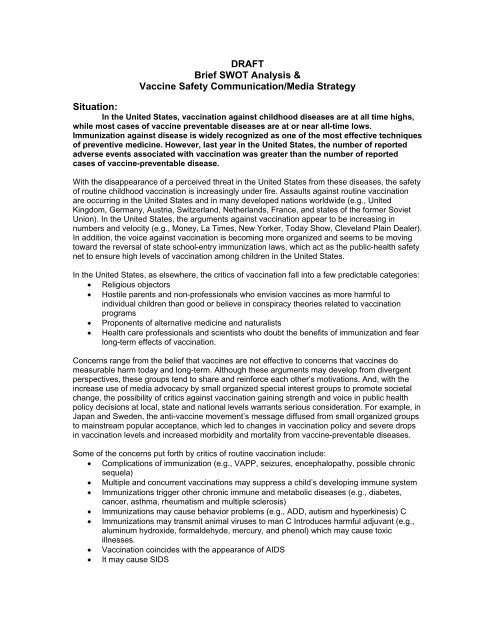
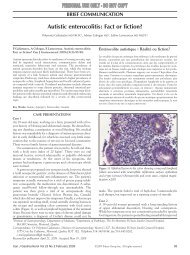

![Got [Camel] Milk?](https://img.yumpu.com/47112650/1/190x259/got-camel-milk.jpg?quality=85)
